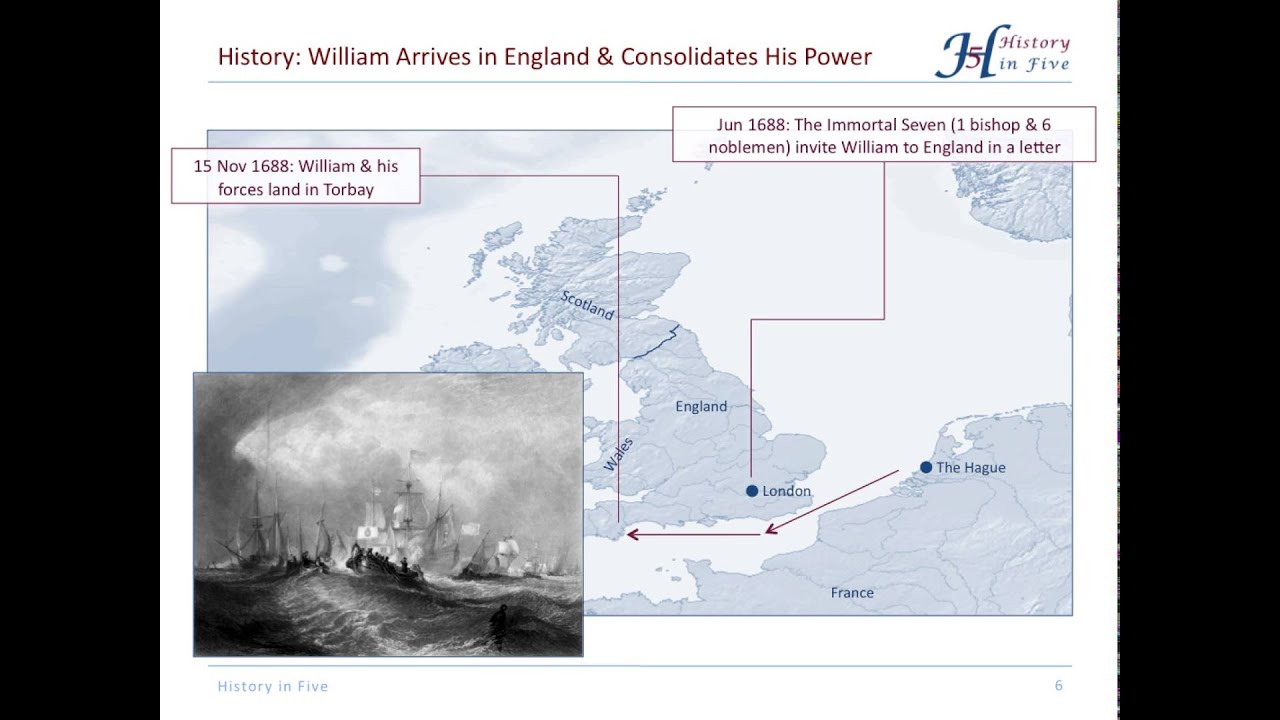The result was the Glorious Revolution, a coup d’etat engineered at first by a group of James’s parliamentary opponents who were called Whigs, in contrast to the Tories who tended to support at least some of the policies of the later Stuarts. The Whigs were the heirs of the moderates of the Long Parliament, and they represented an alliance of the great lords and the prosperous London merchants.
James II married twice. By his first marriage he had two daughters, both Protestant—Mary, who had married William of Orange, the Dutch opponent of Louis XIV, and Anne. Then in 1688 a son was born to James and his Catholic second wife, thus apparently making the passage of the crown to a Catholic heir inevitable. The Whig leaders responded with propaganda, including rumors that the queen had never been pregnant, that a baby had been smuggled into her chamber in a warming pan so that there might be a Catholic heir. Then the Whigs and some Tories negotiated with William of Orange, who could hardly turn down a proposition that would give him the solid assets of English power in his struggle with Louis XIV.
He accepted the invitation to take the English crown, which he was to share with his wife, the couple reigning as William III (r. 1689-1702) and Mary II (r. 1689– 1694). On November 5, 1688, William landed at Torbay on the Devon coast with some fourteen thousand soldiers. When James heard the news he tried to rally support in the West Country, but everywhere the great lords and even the normally conservative gentry were on the side of a Protestant succession. James fled from London to France in December 1688, giving William an almost bloodless victory.
Early in 1689 Parliament (technically a convention, since there was no monarch to summon it) formally offered the crown to William. Enactment of a Bill of Rights followed. This document, summing up the constitutional practices that Parliament had been seeking since the Petition of Right in 1628, was, in fact, almost a short written constitution. It laid down the essential principles of parliamentary supremacy: control of the purse, prohibition of the royal power of dispensation, and frequent meetings of Parliament.
Three major steps were necessary after 1689 to convert Britain into a parliamentary democracy with the Crown as the purely symbolic focus of patriotic loyalty. These, were, first, the concentration of executive direction in a committee of the majority parry in the Parliament, that is, a cabinet headed by a prime minister, achieved in the eighteenth and early nineteenth centuries; second, the establishment of universal suffrage and payment to members of the Commons, achieved in the nineteenth and twentieth centuries; and third, the abolition of the power of the House of Lords to veto legislation passed by the Commons, achieved in the early twentieth century. Thus democracy was still a long way off in 1689, and William and Mary were real rulers with power over policy.
Childless, they were succeeded by Mary’s younger sister Anne (r. 1702-1714), all of whose many children were stillborn or died in childhood. The exiled Catholic Stuarts, however, did better; the little boy born to James II in 1688 and brought up near Paris grew up to be known as the “Old Pretender.” Then in 1701 Parliament passed an Act of Settlement that settled the crown—in default of heirs to Anne, then heir presumptive to the sick William III—not on the Catholic pretender, but on the Protestant Sophia of Hanover or her issue. Sophia was a granddaughter of James I and the daughter of Frederick of the Palatinate, the “Winter King” of Bohemia in the Thirty Years’ War. On Anne’s death in 1714, the crown passed to Sophia’s son George, first king of the house of Hanover. This settlement made it clear that Parliament, and not the divinely ordained succession of the eldest male in direct descent, made the kings of England.
To ensure the Hanoverian succession in both Stuart kingdoms, Scotland as well as England, the formal union of the two was completed in 1707 as the United Kingdom of Great Britain. Scotland gave up its own parliament and sent representatives to the parliament of the United Kingdom at Westminster. Although the union met with some opposition from both English and Scots, on the whole it went through with ease, so great was Protestant fear of a possible return of the Catholic Stuarts.
The Glorious Revolution did not, however, settle the other chronic problem—Ireland. The Catholic Irish rose in support of the exiled James II and were put down at the battle of the Boyne in 1690. William then attempted to apply moderation in his dealings with Ireland, but the Protestants there soon forced him to return to the Cromwellian policy. Although Catholic worship was not actually forbidden, many galling restrictions were imposed on the Catholic Irish, including the prohibition of Catholic schools.
Moreover, economic persecution was added to religious, as Irish trade came under stringent mercantilist regulation. This was the Ireland whose deep misery inspired the writer Jonathan Swift (1667-1745) in 1729 to make his satirical “modest proposal,” that the impoverished Irish sell their babies as articles of food.
Absolutism was thus almost universal in Europe. On the Continent enlightened despots ruled with an often intelligent but determined hand. In the British Isles a tenuous balance had been struck, though for those outside the United Kingdom the rule of the monarch was no less absolute and perhaps less enlightened. While writers of genius might criticize governments, everyman still had no way of doing so, save through peasant revolts.

